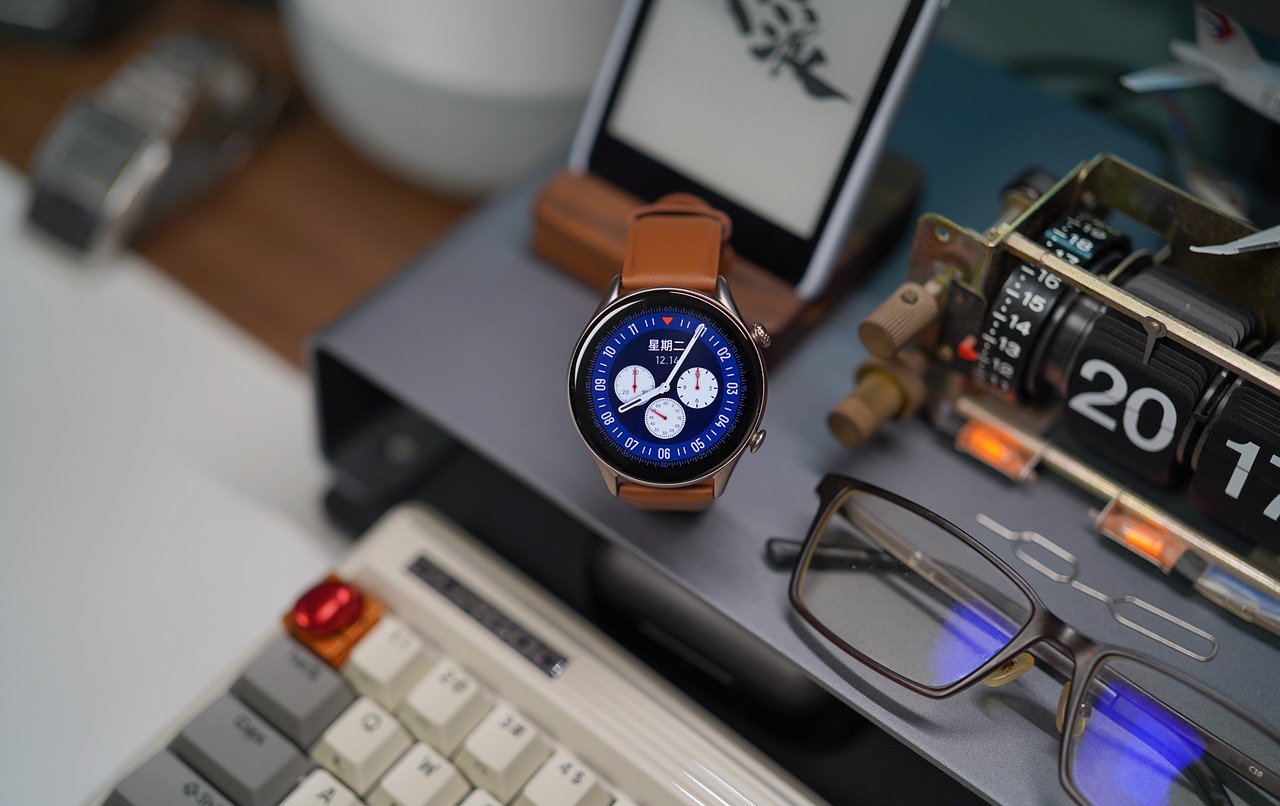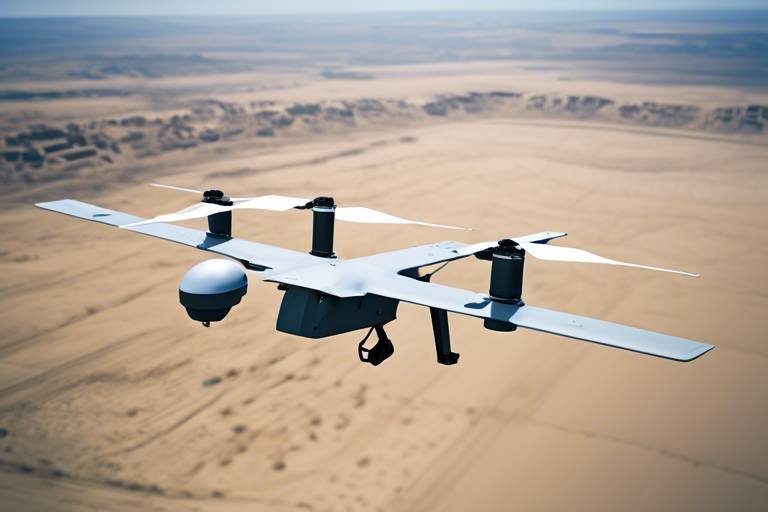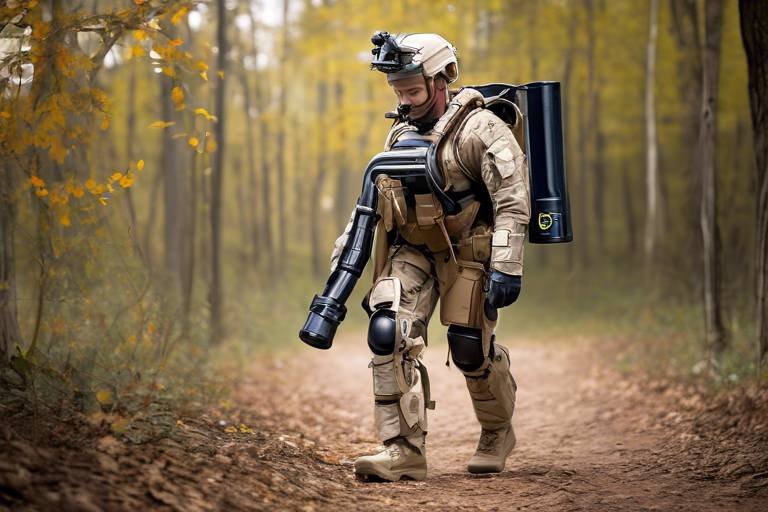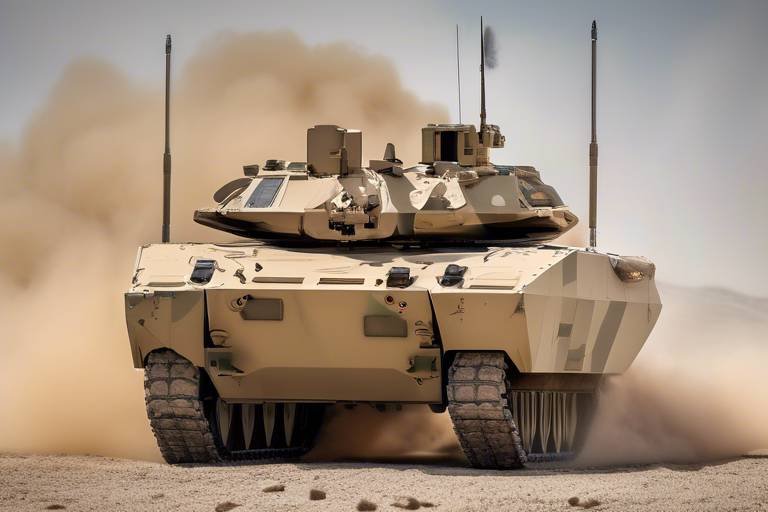Evaluating the Effectiveness of Smart Munitions in Combat
In the ever-evolving landscape of warfare, the introduction of smart munitions has revolutionized how military operations are conducted. These high-tech weapons are designed with precision in mind, aiming to strike targets accurately while minimizing unintended damage. But just how effective are they in real combat scenarios? This article dives deep into the role and impact of smart munitions, assessing their precision, technological advancements, and overall effectiveness compared to their traditional counterparts.
To truly appreciate the effectiveness of smart munitions, one must first understand their evolution. Initially, conventional munitions relied heavily on brute force and sheer volume, often resulting in significant collateral damage. However, as military conflicts became more complex, the need for greater precision became apparent. Enter smart munitions—these advanced weapons systems incorporate a variety of guidance technologies, allowing for pinpoint accuracy in targeting. This shift not only enhances operational efficiency but also addresses ethical concerns surrounding civilian safety in conflict zones.
As we evaluate the effectiveness of smart munitions, it’s essential to explore the different types available. From guided bombs to sophisticated missiles, each type serves a unique purpose in combat. For instance, guided bombs utilize advanced guidance systems to ensure that they hit their intended targets with high accuracy. This is crucial in urban warfare, where the risk of collateral damage is significantly heightened. Missiles, on the other hand, provide long-range strike capabilities, enabling military forces to engage targets from a distance without putting personnel in harm's way.
Another critical aspect to consider is the technological advancements that have propelled smart munitions to the forefront of modern warfare. The integration of technologies such as GPS and laser guidance has transformed how military operations are executed. With GPS-guided munitions, for example, forces can achieve levels of accuracy previously thought impossible. This not only increases the effectiveness of airstrikes but also allows for more strategic planning in military operations.
However, while the advantages of smart munitions are clear, they are not without their challenges. Technological vulnerabilities pose a significant threat, as these systems can be susceptible to countermeasures and jamming. This means that in a highly contested environment, the effectiveness of smart munitions can be compromised. Moreover, the ethical implications of using such technology in warfare cannot be overlooked. The potential for civilian casualties, even with precision-guided munitions, raises important moral questions that military strategists must grapple with.
Looking to the future, the potential for smart munitions is immense. With ongoing advancements in technology, including the integration of artificial intelligence, the effectiveness of these weapons is likely to increase even further. Imagine a battlefield where AI systems analyze real-time data to enhance targeting accuracy and decision-making processes. The implications for military operations could be transformative, paving the way for a new era of warfare.
- What are smart munitions? Smart munitions are advanced weapon systems designed for precision targeting, minimizing collateral damage in combat scenarios.
- How do smart munitions differ from traditional munitions? Unlike traditional munitions that rely on sheer force, smart munitions utilize guidance technologies for enhanced accuracy.
- What are the main types of smart munitions? The main types include guided bombs, missiles, and artillery shells, each tailored for specific combat situations.
- What are the ethical implications of using smart munitions? The use of smart munitions raises questions about civilian safety and the moral responsibilities of military forces in combat.
- What does the future hold for smart munitions? The future looks promising with advancements in AI and next-generation technologies set to enhance their effectiveness even further.

Introduction to Smart Munitions
Smart munitions represent a revolutionary leap in military technology, tailored to enhance the precision of strikes while minimizing the risk of collateral damage. Imagine a world where a missile can hit a target with pinpoint accuracy, reducing the likelihood of unintended destruction—this is the essence of smart munitions. These advanced weapons systems have evolved significantly over the decades, transitioning from traditional explosive devices to sophisticated, guided technologies that utilize state-of-the-art navigation and targeting systems.
The journey of smart munitions began in the mid-20th century, but it wasn’t until the Gulf War in the early 1990s that the world truly witnessed their potential. During this conflict, the U.S. military deployed precision-guided munitions (PGMs) extensively, showcasing their effectiveness in striking high-value targets while minimizing civilian casualties. This marked a pivotal moment in warfare, as the emphasis shifted from sheer firepower to strategic precision.
So, what exactly qualifies a munition as "smart"? In essence, smart munitions are equipped with advanced guidance systems that allow them to adjust their flight path mid-course, ensuring they reach their intended target with remarkable accuracy. These systems can include laser guidance, GPS navigation, and even advanced sensors that can identify and track targets autonomously. The result is a new breed of weaponry that not only increases the effectiveness of military operations but also aligns with modern ethical standards of warfare.
As we delve deeper into the various types of smart munitions, it’s crucial to understand their unique features and applications. From guided bombs to missiles, each type serves a specific purpose on the battlefield. The integration of technology into these systems has not only transformed how wars are fought but has also raised important questions about the future of combat and the ethical implications of using such advanced weaponry.
In the following sections, we will explore the different categories of smart munitions, their advantages, challenges, and what the future holds for this fascinating aspect of military technology. Buckle up, as we take a closer look at how these innovations are shaping the landscape of modern warfare!

Types of Smart Munitions
Smart munitions have revolutionized modern warfare by providing a variety of options tailored for different combat scenarios. These advanced weapons are designed not only to hit their targets with pinpoint accuracy but also to minimize unintended damage to surrounding areas. This section will delve into the various types of smart munitions, including guided bombs, missiles, and artillery shells, each with unique features and applications that enhance their effectiveness on the battlefield.
First up, we have guided bombs, which are perhaps the most recognizable form of smart munitions. These bombs utilize sophisticated guidance systems to ensure they strike their intended targets with remarkable precision. The effectiveness of guided bombs has been demonstrated in numerous conflicts, showcasing their ability to engage high-value targets while significantly reducing the risk of collateral damage. Within this category, there are two primary types: laser-guided munitions and GPS-guided munitions.
Guided bombs come equipped with various technologies to enhance their targeting capabilities. For instance, laser-guided bombs use a laser designator to illuminate the target, allowing the bomb to home in on the reflected laser light. This method ensures high accuracy, especially in urban environments where precision is crucial. In contrast, GPS-guided bombs utilize satellite navigation systems to determine their trajectory, making them effective even in adverse weather conditions. The table below summarizes the key differences between these two types of guided bombs:
| Type | Guidance Method | Advantages |
|---|---|---|
| Laser-Guided Munitions | Laser Designation | High accuracy in close-range strikes |
| GPS-Guided Munitions | Satellite Navigation | Effective in all weather conditions |
Next, we have missiles, which are critical components of modern military arsenals. Missiles offer long-range strike capabilities, allowing forces to engage targets from a safe distance. They come in various types, including cruise missiles and ballistic missiles, each designed for specific operational needs. Cruise missiles are known for their ability to fly low to evade radar detection, making them stealthy and effective against fortified positions. On the other hand, ballistic missiles are launched at high angles and are capable of delivering payloads over vast distances, making them strategic assets in any military operation.
Missiles can be equipped with a variety of guidance systems, including inertial navigation, terminal guidance, and even advanced technologies like imaging infrared. The versatility of missiles allows them to be employed in numerous scenarios, from striking ground targets to intercepting aerial threats. Their strategic importance cannot be overstated, as they provide a means of deterrence and offensive capability that traditional munitions simply cannot match.
Finally, artillery shells have also evolved to include smart technology. These shells can be equipped with guidance systems that enhance their accuracy over traditional unguided artillery. Smart artillery shells can adjust their trajectory mid-flight, ensuring they land precisely where intended. This capability has made them invaluable in supporting ground troops while minimizing the risk of collateral damage.
In summary, the types of smart munitions available today are diverse and tailored for various combat situations. From guided bombs that ensure accuracy to missiles that provide long-range strike capabilities and smart artillery shells that enhance precision, these advanced weapons are changing the face of warfare. As technology continues to advance, we can expect even more innovations in smart munitions, further enhancing their effectiveness on the battlefield.
- What are smart munitions? Smart munitions are advanced weapons designed to enhance accuracy and reduce collateral damage in military operations.
- How do guided bombs work? Guided bombs use various guidance systems, such as laser designation or GPS, to accurately strike targets.
- What is the difference between cruise missiles and ballistic missiles? Cruise missiles are designed for low-level flight and stealth, while ballistic missiles are launched at high angles and cover greater distances.
- What role do smart artillery shells play in combat? Smart artillery shells improve accuracy and precision, allowing for effective support of ground troops with minimal collateral damage.

Guided Bombs
Guided bombs are a remarkable leap forward in the realm of military technology, specifically designed to enhance the precision of airstrikes. Unlike traditional unguided bombs, which can be notoriously inaccurate and lead to unintended destruction, guided bombs utilize sophisticated guidance systems that ensure they hit their intended targets with remarkable accuracy. This transformation in bombing capabilities has revolutionized modern warfare, allowing military forces to strike with pinpoint precision while minimizing collateral damage.
At their core, guided bombs are equipped with advanced targeting mechanisms that can include laser guidance, GPS navigation, or even inertial navigation systems. These technologies work together to provide real-time data about the bomb's trajectory, ensuring that it stays on course towards its target. For example, laser-guided bombs (LGBs) use a laser designator to illuminate the target, allowing the bomb to home in on the reflected laser light. This method has proven highly effective in various combat scenarios, particularly in urban environments where precision is paramount.
In contrast, GPS-guided bombs rely on satellite navigation to achieve their accuracy. This technology has transformed the way airstrikes are conducted, enabling military forces to strike targets from great distances, often without direct visual contact. The integration of GPS technology not only increases the effectiveness of these munitions but also enhances the safety of pilots and ground troops. The ability to engage targets from a distance significantly reduces the risk of exposure to enemy fire.
Notable use cases of guided bombs in recent conflicts demonstrate their effectiveness and strategic importance. For instance, during the Gulf War, the United States military showcased the capabilities of guided bombs, achieving a high level of accuracy that was previously unattainable. The ability to destroy critical infrastructure and enemy positions while minimizing civilian casualties has made guided bombs a preferred choice for military planners.
However, it is important to acknowledge that while guided bombs represent a significant advancement, they are not without their challenges. The reliance on technology means that guided bombs can be vulnerable to countermeasures, such as electronic jamming or laser interference. Additionally, the ethical implications of using such precise weaponry in combat situations raise questions about the moral responsibilities of military forces.
Overall, guided bombs epitomize the evolution of warfare, embodying the shift towards more precise and responsible military engagements. As technology continues to advance, we can expect guided bombs to become even more sophisticated, further enhancing their effectiveness on the battlefield.
- What are guided bombs? Guided bombs are precision munitions that use advanced targeting systems to accurately strike specific targets while minimizing collateral damage.
- How do guided bombs work? They utilize various technologies, including laser guidance and GPS navigation, to ensure they hit their intended targets accurately.
- What are the advantages of using guided bombs? The main advantages include increased accuracy, reduced collateral damage, and the ability to engage targets from a safe distance.
- Can guided bombs be countered? Yes, guided bombs can be vulnerable to electronic jamming and other countermeasures that may disrupt their guidance systems.
- What ethical considerations are associated with guided bombs? The use of guided bombs raises moral questions regarding civilian safety and the responsibilities of military forces in warfare.

Laser-Guided Munitions
Laser-guided munitions represent a remarkable leap forward in the precision of military strikes, utilizing the power of laser technology to achieve pinpoint accuracy. Imagine a world where a bomb can be directed to hit a target with the precision of a surgeon's scalpel—that's the essence of laser-guided munitions. These weapons are equipped with a laser seeker that locks onto a target illuminated by a laser designator, which can be operated either from the ground or from an aircraft. This technology allows for a high degree of accuracy, significantly reducing the chances of collateral damage and civilian casualties.
The operational principle behind laser-guided munitions is relatively straightforward yet highly effective. When a target is designated with a laser beam, the munition homes in on that beam, adjusting its flight path in real time to ensure a direct hit. This capability is particularly advantageous in urban warfare scenarios, where the risk of hitting non-combatants is elevated. In fact, the precision offered by laser-guided munitions has redefined engagement rules for military operations, allowing forces to strike high-value targets with minimal risk to surrounding areas.
One of the standout features of laser-guided munitions is their versatility. They can be deployed from various platforms, including fighter jets, helicopters, and even ground-based units. This flexibility allows military planners to adapt their strategies based on the specific needs of a mission. For instance, during the Gulf War, laser-guided bombs were famously used to target Iraqi command and control centers, showcasing their effectiveness in delivering precise strikes against critical infrastructure.
However, while the advantages of laser-guided munitions are substantial, they are not without limitations. Weather conditions, such as rain or fog, can obstruct the laser beam, potentially compromising accuracy. Additionally, the requirement for a laser designator means that the target must be illuminated throughout the munition's flight, which can expose the operator to enemy fire. Despite these challenges, the benefits often outweigh the drawbacks, making laser-guided munitions a preferred choice for many military operations.
In summary, laser-guided munitions have transformed modern warfare by providing unparalleled precision and reducing the risk of collateral damage. As technology continues to evolve, we can expect to see even more sophisticated systems that enhance the effectiveness of these munitions on the battlefield.
- What are laser-guided munitions?
Laser-guided munitions are precision weapons that use laser technology to guide them to their target. - How do laser-guided munitions work?
They work by locking onto a target illuminated by a laser designator, adjusting their flight path to hit the target accurately. - What are the advantages of using laser-guided munitions?
They offer high accuracy, reduced collateral damage, and can be deployed from various platforms. - Are there any limitations to laser-guided munitions?
Yes, they can be affected by weather conditions and require continuous illumination of the target.

GPS-Guided Munitions
GPS-guided munitions have revolutionized the way military operations are conducted, introducing a level of precision that was previously unimaginable. These advanced weapons systems utilize satellite navigation to accurately strike targets, drastically reducing the risk of collateral damage. Imagine a world where a bomb can hit a specific window of a building, while avoiding the surrounding homes—this is the reality that GPS-guided munitions bring to modern warfare.
The essence of GPS-guided munitions lies in their ability to receive signals from a network of satellites orbiting the Earth. This information allows the munition to adjust its flight path in real time, ensuring it reaches its intended target with remarkable accuracy. A significant advantage of this technology is its adaptability in various combat scenarios. Whether it's a precision airstrike against a high-value target or a tactical operation in urban environments, GPS-guided munitions can be deployed effectively.
One of the standout features of GPS-guided munitions is their versatility. They can be integrated into various platforms, including aircraft, drones, and even ground vehicles. This flexibility means that military forces can deploy these munitions across a wide range of operations, from air-to-ground strikes to naval engagements. Notably, the use of GPS technology has led to a dramatic increase in successful strike rates, with reports indicating that these munitions have achieved accuracy rates exceeding 90%.
However, it’s not all sunshine and rainbows. The reliance on GPS does introduce vulnerabilities. For instance, in environments where GPS signals can be jammed or spoofed, the effectiveness of these munitions can be compromised. This has led military strategists to consider alternative guidance systems and backup plans to ensure operational success. Nevertheless, the benefits of GPS-guided munitions far outweigh these challenges, making them a cornerstone of contemporary military strategy.
To illustrate their effectiveness, let’s look at a few notable examples:
| Conflict | Year | Use of GPS-Guided Munitions |
|---|---|---|
| Operation Desert Storm | 1991 | First significant use of GPS-guided bombs, achieving high accuracy in strikes. |
| Operation Iraqi Freedom | 2003 | Extensive use of GPS-guided munitions in urban combat, minimizing civilian casualties. |
| Operation Enduring Freedom | 2001-2014 | Utilization of GPS technology for precision strikes in complex environments. |
In conclusion, GPS-guided munitions represent a leap forward in military technology, enabling forces to conduct operations with unprecedented precision. While challenges exist, the ongoing advancements in this field promise to enhance their capabilities further, ensuring that they remain a vital asset in the arsenal of modern warfare.
- What are GPS-guided munitions?
GPS-guided munitions are precision weapons that utilize satellite navigation to accurately strike targets, minimizing collateral damage. - How do GPS-guided munitions enhance military operations?
They provide high accuracy and adaptability across various combat scenarios, significantly increasing successful strike rates. - What are the vulnerabilities of GPS-guided munitions?
They can be susceptible to jamming or spoofing of GPS signals, which can compromise their effectiveness in certain environments. - Are GPS-guided munitions cost-effective?
While they may be more expensive initially, their precision can lead to cost savings in the long run by reducing collateral damage and increasing mission success rates.

Missiles and Their Applications
Missiles have become a cornerstone of modern military strategy, offering unparalleled long-range strike capabilities that can change the tide of battle. Unlike traditional artillery, which often requires close proximity to the target, missiles can be launched from a safe distance, allowing military forces to engage enemy assets without exposing themselves to immediate danger. This capability is crucial in today's fast-paced combat environments, where speed and precision are paramount.
There are several types of missiles, each designed for specific roles in combat scenarios. These include cruise missiles, ballistic missiles, anti-ship missiles, and surface-to-air missiles. Each type has its own unique guidance systems and operational applications:
| Type of Missile | Guidance System | Typical Use |
|---|---|---|
| Cruise Missiles | GPS/INS | Precision strikes against ground targets |
| Ballistic Missiles | Inertial/GPS | Long-range strategic attacks |
| Anti-Ship Missiles | Active radar/Infrared | Engaging naval vessels |
| Surface-to-Air Missiles | Radar/Infrared | Defense against aerial threats |
One of the most significant advantages of missiles is their ability to strike with high precision, minimizing the risk of collateral damage. For instance, cruise missiles, which can be guided to their targets with pinpoint accuracy, have proven effective in various military operations. Their ability to fly at low altitudes and navigate around terrain makes them difficult to detect and intercept, enhancing their effectiveness on the battlefield.
Moreover, the strategic importance of missiles cannot be overstated. They serve not only as weapons of destruction but also as tools for deterrence. Nations equipped with advanced missile systems can project power and influence, thereby altering the geopolitical landscape. The presence of these systems often serves as a deterrent to potential aggressors, as the consequences of engaging a missile-capable nation can be catastrophic.
In recent conflicts, the use of missiles has evolved significantly, with advancements in technology leading to the development of hypersonic missiles. These next-generation weapons can travel at speeds exceeding Mach 5, making them incredibly challenging to defend against. The implications of such technology are profound, as they could potentially render existing missile defense systems obsolete, leading to a new arms race in missile technology.
As military forces continue to innovate, the applications of missiles will likely expand even further. The integration of artificial intelligence into missile systems is on the horizon, promising to enhance targeting accuracy and decision-making processes in real-time combat scenarios. This evolution represents a significant leap forward, enabling military strategists to respond more effectively to dynamic battlefield conditions.
- What are the main types of missiles used in modern warfare? Modern warfare utilizes various types of missiles, including cruise missiles, ballistic missiles, anti-ship missiles, and surface-to-air missiles, each serving distinct purposes.
- How do missiles reduce collateral damage? Missiles, particularly cruise missiles, are designed with advanced guidance systems that allow for precise targeting, which significantly reduces the risk of collateral damage.
- What is the role of missiles in military strategy? Missiles play a crucial role in military strategy by providing long-range strike capabilities, enhancing deterrence, and allowing for precision strikes without exposing forces to direct threats.
- What advancements are being made in missile technology? Advancements in missile technology include the development of hypersonic missiles and the integration of artificial intelligence for improved targeting and decision-making.

Advantages of Smart Munitions
Smart munitions have transformed the battlefield landscape, offering a plethora of advantages that traditional munitions simply cannot match. One of the most significant benefits is their increased accuracy. Unlike conventional bombs that may scatter over a wide area, smart munitions are designed to hit specific targets with pinpoint precision. This capability not only enhances the effectiveness of military operations but also plays a crucial role in minimizing collateral damage. In an age where civilian safety is paramount, the ability to strike with surgical precision is a game changer.
Moreover, the operational efficiency of smart munitions cannot be overlooked. By using advanced guidance systems, these munitions can adapt to changing battlefield conditions, ensuring that they remain effective even in complex environments. For instance, guided bombs can adjust their trajectory mid-flight, increasing the chances of a successful strike. This adaptability is essential in modern warfare, where the battlefield is constantly evolving and unpredictable.
Another compelling advantage of smart munitions is their cost-effectiveness. While the initial investment in developing and deploying smart munitions may be higher compared to traditional options, the long-term savings can be substantial. The precision of these munitions often leads to fewer resources being wasted on missed targets, and the reduced need for follow-up strikes can significantly lower operational costs. In essence, investing in smart munitions can be seen as a strategic move that pays off over time.
Furthermore, the ethical implications of using smart munitions are noteworthy. The reduced collateral damage associated with their use not only protects civilian lives but also enhances the moral standing of military operations. In today's world, where public opinion can sway the outcomes of military engagements, the ability to conduct operations with greater accountability is invaluable. By minimizing unintended harm, military forces can maintain legitimacy and support for their actions.
To summarize, the advantages of smart munitions can be encapsulated in the following key points:
- Increased accuracy leading to effective target engagement.
- Operational efficiency through adaptability in dynamic environments.
- Cost-effectiveness in the long run due to reduced resource wastage.
- Ethical implications that enhance the legitimacy of military operations.
As military technology continues to evolve, the advantages of smart munitions will likely become even more pronounced, shaping the future of warfare in ways we can only begin to imagine.

Cost-Effectiveness
When we think about the battlefield, one of the first things that come to mind is the staggering cost of military operations. Smart munitions, while often more expensive upfront compared to traditional weapons, can actually turn out to be a cost-effective solution in the long run. This is primarily because they are designed to hit their targets with remarkable precision, which significantly reduces the need for multiple strikes. Imagine throwing darts at a dartboard; if you hit the bullseye on the first try, you save time, effort, and resources. The same principle applies here.
To break it down further, let's consider a few key factors that contribute to the cost-effectiveness of smart munitions:
- Reduced Resource Consumption: Traditional munitions often require multiple attempts to achieve a successful strike. In contrast, smart munitions can achieve their objectives with fewer launches, thereby conserving both ammunition and fuel.
- Lower Collateral Damage Costs: The precision of smart munitions means that they are less likely to cause unintended damage to surrounding areas. This not only saves on potential reparations but also minimizes the risk of civilian casualties, which can lead to costly political repercussions.
- Operational Efficiency: With their advanced technology, smart munitions streamline military operations. They allow for faster decision-making and execution, which can be crucial in time-sensitive situations.
While the initial investment in smart munitions might raise eyebrows, the long-term savings and strategic advantages they bring to military operations can make them a wise investment. In fact, studies have shown that the total lifecycle cost of using smart munitions can be lower than that of traditional munitions when considering factors such as operational efficiency and reduced collateral damage. This is a crucial consideration for military planners who are tasked with balancing budgets while ensuring mission success.
Moreover, as technology continues to advance, the costs associated with the development and production of smart munitions are expected to decrease. As more countries adopt these technologies, economies of scale will likely come into play, making them more accessible and affordable. This shift could usher in a new era of military engagement where the focus is not just on the quantity of munitions but on their quality and effectiveness.
In summary, while the sticker price of smart munitions might initially seem daunting, their overall cost-effectiveness, when viewed through the lens of strategic military operations, becomes clear. They not only save resources but also help in maintaining a more ethical approach to warfare by minimizing collateral damage. As we look to the future, investing in smart munitions could very well be the smart choice for military forces around the globe.
- What are smart munitions? Smart munitions are advanced military weapons designed to enhance targeting accuracy and reduce collateral damage.
- Are smart munitions more expensive than traditional munitions? Yes, they typically have a higher upfront cost, but their precision can lead to cost savings over time.
- How do smart munitions reduce collateral damage? Their advanced guidance systems allow for more precise targeting, minimizing the risk of unintended damage to surrounding areas.
- What is the future of smart munitions? Ongoing advancements in technology, including AI integration, are expected to enhance their effectiveness and affordability.

Reduced Collateral Damage
The modern battlefield is a complex and unpredictable environment, where the stakes are incredibly high. One of the most significant advantages of smart munitions is their ability to minimize collateral damage. In traditional warfare, precision was often sacrificed for firepower, leading to unintended destruction of civilian infrastructure and loss of innocent lives. However, with the advent of smart munitions, military forces can engage targets with a level of accuracy that was previously unimaginable.
Smart munitions, such as guided bombs and missiles, are equipped with advanced targeting systems that allow them to hit specific points with pinpoint accuracy. This precision not only enhances the effectiveness of military operations but also significantly reduces the risk of collateral damage. For example, during recent conflicts, the use of GPS-guided munitions has demonstrated a remarkable ability to strike enemy installations while avoiding nearby civilian areas. This capability is crucial in urban warfare, where the line between combatants and non-combatants is often blurred.
Moreover, the ethical implications of using smart munitions cannot be overstated. By reducing collateral damage, militaries can uphold their commitment to international humanitarian laws and minimize the moral dilemmas associated with warfare. The ability to conduct operations with greater precision allows military planners to make better decisions, weighing the necessity of a strike against the potential for civilian harm. This is particularly important in today's world, where public opinion can be swayed by images of civilian casualties.
To illustrate the effectiveness of smart munitions in reducing collateral damage, consider the following table that compares traditional munitions with smart munitions in terms of accuracy and impact:
| Munitions Type | Accuracy (meters) | Collateral Damage Potential |
|---|---|---|
| Traditional Munitions | 100-300 | High |
| Smart Munitions | 1-10 | Low |
This table clearly shows that while traditional munitions can have a wide impact radius, smart munitions are designed to strike with remarkable precision, thereby significantly reducing the potential for unintended damage. As technology continues to advance, the effectiveness of smart munitions in minimizing collateral damage is expected to improve even further, paving the way for more ethical and responsible military operations.
In conclusion, the reduced collateral damage associated with smart munitions not only enhances operational effectiveness but also aligns with the ethical considerations of modern warfare. As we move forward, the challenge will be to continue developing these technologies while ensuring that they are used responsibly and judiciously in combat scenarios.
- What are smart munitions? Smart munitions are advanced weapons designed to enhance targeting accuracy and minimize unintended damage during military operations.
- How do smart munitions reduce collateral damage? They utilize advanced guidance systems, such as GPS and laser guidance, allowing for precise targeting of enemy assets while avoiding civilian areas.
- Are smart munitions more expensive than traditional munitions? Yes, they often come at a higher cost, but their precision can lead to cost savings in the long run by reducing the need for additional strikes and minimizing collateral damage.
- What ethical considerations are associated with smart munitions? The use of smart munitions raises questions about the morality of warfare, particularly regarding civilian safety and the responsibilities of military forces to minimize harm.

Challenges and Limitations
Despite the impressive advancements and numerous benefits of smart munitions, they are not without their challenges and limitations. As we navigate the complex landscape of modern warfare, understanding these hurdles is crucial for military strategists and policymakers alike. One of the primary challenges lies in the technological vulnerabilities that smart munitions face. While these munitions are designed to enhance precision and effectiveness, they can also be susceptible to various countermeasures. For instance, electronic jamming and spoofing techniques can disrupt the guidance systems of these advanced weapons, rendering them less effective or even completely ineffective in the heat of battle.
Moreover, the reliance on technology introduces a level of unpredictability. Imagine a soldier in a combat zone, relying on a sophisticated GPS-guided missile. If the satellite navigation system is compromised, the outcome could be disastrous. This raises an important question: can we truly depend on technology in the chaos of war? The answer is not straightforward. While smart munitions have proven their worth in many scenarios, their performance can be dramatically affected by environmental conditions or enemy tactics.
Additionally, the ethical considerations surrounding the use of smart munitions cannot be overlooked. As military forces strive to minimize civilian casualties, the deployment of these advanced weapons raises moral dilemmas. Are we crossing a line when we rely on machines to make life-and-death decisions? The potential for miscalculations or failures can lead to unintended consequences, resulting in loss of innocent lives and further complicating the already intricate nature of warfare.
Furthermore, the cost of smart munitions poses a significant limitation. Although they are designed to be more accurate and efficient, the initial investment required for research, development, and production can be astronomical. Many military budgets are strained, and the allocation of funds towards smart munitions can divert resources from other critical areas. The question arises: is the investment justified when traditional munitions can still achieve similar objectives at a fraction of the cost? This financial aspect is a critical consideration for military planners.
In summary, while smart munitions represent a technological leap forward, they are not a panacea for the challenges of modern warfare. Their technological vulnerabilities, ethical implications, and cost considerations present significant hurdles that must be addressed. As we look to the future, it is essential to strike a balance between leveraging innovative technologies and acknowledging their limitations. Only then can we effectively navigate the complexities of combat in a way that prioritizes both operational success and humanitarian concerns.
- What are smart munitions? Smart munitions are advanced weapons designed to enhance targeting accuracy and reduce collateral damage in military operations.
- What are the main challenges associated with smart munitions? The main challenges include technological vulnerabilities, ethical considerations, and high costs.
- How do smart munitions differ from traditional munitions? Smart munitions utilize advanced guidance systems for precision targeting, while traditional munitions lack these capabilities.
- Can smart munitions fail in combat? Yes, they can be susceptible to countermeasures like jamming, and environmental factors can affect their performance.

Technological Vulnerabilities
While smart munitions are heralded as the pinnacle of modern military technology, they are not without their . These advanced weapons, designed for precision and efficiency, can fall prey to various countermeasures that adversaries might deploy. For instance, electronic warfare tactics, such as jamming, can disrupt the guidance systems of these munitions, rendering them less effective or completely inoperable. Imagine a high-tech missile, equipped with the latest satellite navigation, suddenly losing its signal due to enemy interference. It’s akin to a ship lost at sea without its compass—navigationally adrift and vulnerable.
Moreover, the reliance on sophisticated technology means that any failure in the systems can lead to catastrophic results. A minor glitch in the software or a hardware malfunction can compromise the mission, potentially leading to unintended consequences. For example, if a GPS-guided bomb loses its connection to satellites, it may miss its target entirely, leading to collateral damage rather than the precision strikes it was designed for. This unpredictability raises questions about the overall reliability of smart munitions in high-stakes combat situations.
Another significant vulnerability lies in the cost and accessibility of countermeasures. As smart munitions become more common, so do the methods to counteract them. Countries with less advanced military technology can invest in relatively inexpensive jamming devices or spoofing technologies that mislead the guidance systems of smart munitions. This increasing accessibility of countermeasures means that the advantage of using smart munitions may diminish over time, as adversaries adapt and develop their own strategies to neutralize these weapons.
In summary, while smart munitions offer unparalleled benefits in terms of accuracy and efficiency, their technological vulnerabilities present significant challenges. As military operations evolve, understanding these vulnerabilities will be crucial for strategists and operators alike. The dynamic nature of warfare means that reliance on technology must be matched with robust counter-countermeasures to ensure that these advanced weapons can operate effectively in the field.
- What are smart munitions? Smart munitions are advanced weapons designed for precision targeting, minimizing collateral damage in combat situations.
- How do countermeasures affect smart munitions? Countermeasures such as jamming can disrupt the guidance systems of smart munitions, potentially leading to mission failure.
- What are the implications of technological vulnerabilities? Technological vulnerabilities can compromise the effectiveness of smart munitions, leading to unintended consequences and increased risk during military operations.
- How can militaries counteract these vulnerabilities? Militaries must invest in counter-countermeasures and maintain a balance between technological reliance and operational flexibility.

Ethical Considerations
The deployment of smart munitions has ignited a heated debate surrounding the ethical implications of modern warfare. As military technology evolves, so too do the moral questions that accompany its use. Smart munitions, with their increased precision and reduced collateral damage, may seem like a step forward in minimizing civilian casualties. However, this technological advancement also raises significant concerns about accountability and the potential for misuse.
One of the primary ethical considerations is the responsibility of military personnel when utilizing these advanced weapons. The ability to strike with pinpoint accuracy can lead to a false sense of security, where commanders may feel emboldened to engage in combat without fully weighing the consequences. This can create a slippery slope, where the threshold for initiating strikes is lowered, potentially leading to more frequent military engagements.
Moreover, the reliance on technology in warfare can desensitize military personnel to the realities of conflict. When decisions are made based on data and algorithms rather than human judgment, it raises questions about the human element in warfare. Are we at risk of viewing combatants and civilians as mere targets on a screen, rather than as individuals with lives and families? This detachment can lead to moral disengagement, where the gravity of taking a life is diminished in the eyes of those wielding the power of smart munitions.
Another pressing concern is the potential for disproportionate impact on civilian populations. While smart munitions are designed to minimize collateral damage, errors in targeting or failures in technology can still result in tragic consequences. The ethical implications of these failures are profound, as civilian casualties can undermine the legitimacy of military operations and fuel anti-war sentiments. The question remains: can military forces justify the use of smart munitions when the risk of civilian harm, albeit reduced, still exists?
Furthermore, there is the issue of transparency and accountability. In the age of smart warfare, who is held responsible for the decisions made by automated systems? If a military operation goes awry due to a malfunctioning guidance system, who bears the consequences? These questions call for a reevaluation of existing military ethics and the establishment of clear guidelines governing the use of smart munitions in combat.
In summary, while smart munitions offer significant advantages in terms of precision and reduced collateral damage, they also introduce complex ethical dilemmas that cannot be overlooked. The military must navigate these challenges carefully, ensuring that the use of advanced technology does not come at the expense of humanity and moral responsibility. As we look to the future of warfare, it is essential to prioritize ethical considerations alongside technological advancements.
- What are smart munitions? Smart munitions are advanced military weapons designed to enhance accuracy and reduce collateral damage, utilizing guidance systems such as GPS and laser targeting.
- How do smart munitions reduce collateral damage? By improving targeting precision, smart munitions are able to hit specific targets with minimal impact on surrounding areas, thus lowering the risk of civilian casualties.
- What are the ethical implications of using smart munitions? Ethical concerns include accountability for military decisions, the potential desensitization of personnel, the risk of civilian harm, and the need for transparency in military operations.
- Can smart munitions fail? Yes, like all technology, smart munitions can experience failures or errors, which can lead to unintended consequences and civilian casualties.

Future of Smart Munitions
The future of smart munitions is not just bright; it's dazzling with potential. As technology continues to advance at a breakneck pace, we find ourselves on the brink of a new era in military operations. Imagine a battlefield where precision strikes are not just a possibility but a guarantee, thanks to the integration of cutting-edge technologies. The landscape of warfare is evolving, and smart munitions are at the forefront of this transformation.
One of the most exciting developments on the horizon is the integration of artificial intelligence (AI) into smart munitions. Picture this: munitions equipped with AI can analyze real-time data, adjust their flight paths, and make decisions on the fly. This capability could significantly enhance targeting accuracy, reducing the chances of errors that could lead to unintended casualties. AI can help in identifying and prioritizing targets, making the decision-making process faster and more efficient. The implications are staggering; with AI, we could see a dramatic decrease in collateral damage, a goal that has been a cornerstone of modern military strategy.
Moreover, the emergence of next-generation technologies, such as hypersonic munitions, is set to redefine what we consider possible in military engagements. Hypersonic weapons, capable of traveling at speeds greater than five times the speed of sound, can strike targets before adversaries even have a chance to respond. This speed, combined with advanced guidance systems, makes them incredibly difficult to intercept. The table below summarizes some of the key features of these next-generation munitions:
| Type of Munitions | Speed | Guidance System | Range |
|---|---|---|---|
| Hypersonic Missiles | Mach 5+ | AI-assisted | Over 1,000 km |
| Smart Bombs | Subsonic to Supersonic | GPS and Laser-guided | Up to 100 km |
| Directed Energy Weapons | N/A | Targeting Systems | Variable |
As we glance into the future, we can also anticipate a shift towards network-centric warfare, where smart munitions will be part of a larger interconnected system. This approach will allow for seamless communication between various military assets, including drones, ground troops, and command centers. By sharing real-time intelligence and operational data, forces can coordinate their efforts more effectively, leading to enhanced mission success rates.
However, while the advancements are promising, they are not without challenges. The ethical implications of deploying such advanced technologies must be considered. Will the increased reliance on AI and automation in combat lead to a detachment from the human element of warfare? As we push the boundaries of technology, we must also grapple with the moral questions that arise from its use. Ensuring that these technologies are used responsibly and ethically will be crucial as we move forward.
In conclusion, the future of smart munitions is poised for significant advancements that could reshape the battlefield. With the integration of AI and the development of hypersonic technologies, we are looking at a future where military operations can be conducted with unprecedented precision and efficiency. Yet, as we embrace these innovations, we must also remain vigilant about the ethical considerations that come with them. The journey ahead is filled with both opportunities and challenges, and how we navigate this path will determine the effectiveness and morality of modern warfare.
- What are smart munitions? Smart munitions are advanced weapons designed to enhance targeting accuracy and reduce collateral damage in combat.
- How does AI improve smart munitions? AI enhances smart munitions by allowing them to analyze data in real-time, adjust their paths, and make decisions autonomously, leading to improved accuracy and efficiency.
- What are hypersonic munitions? Hypersonic munitions are weapons that travel at speeds greater than five times the speed of sound, making them extremely difficult to intercept.
- What ethical concerns exist regarding smart munitions? The use of smart munitions raises concerns about the potential for dehumanizing warfare, as well as the responsibility for decisions made by AI in combat scenarios.

Integration with AI
As we look towards the future of warfare, the integration of artificial intelligence (AI) into smart munitions is not just a possibility; it’s an impending reality that promises to reshape combat dynamics. Imagine a battlefield where munitions are not only guided by human operators but also enhanced by machine learning algorithms that analyze real-time data to make split-second decisions. This level of sophistication could significantly improve targeting accuracy and operational efficiency, making military operations more effective than ever before.
AI can process vast amounts of information much faster than any human can, allowing for the real-time assessment of threats and the adjustment of targeting parameters on the fly. For instance, during a military engagement, AI systems could evaluate the terrain, weather conditions, and enemy movements, then adjust the trajectory of smart munitions accordingly. This adaptability could be the difference between success and failure in critical missions.
Moreover, the integration of AI into smart munitions can enhance their autonomous capabilities. While traditional munitions require constant human oversight, AI-driven systems could operate with a degree of independence, making them less vulnerable to human error and delays. This autonomy could lead to a new class of munitions that are capable of engaging targets without direct human intervention, thereby reducing the risk to personnel and increasing the speed of response in combat situations.
However, this shift towards AI integration is not without its challenges. The ethical implications of deploying autonomous weapons systems raise significant concerns. Questions about accountability arise: if an AI-operated munition causes unintended harm, who is responsible? Addressing these ethical dilemmas will be crucial as military forces begin to adopt AI technologies in their arsenals.
In summary, the future of smart munitions is intricately linked to advancements in AI. As technology evolves, we can anticipate a new era of warfare where intelligent munitions not only enhance precision but also redefine the very nature of combat. The military landscape will undoubtedly be transformed, making it essential for policymakers to address the accompanying ethical and operational challenges.
- What are smart munitions? Smart munitions are advanced weapons designed to enhance targeting accuracy and minimize collateral damage in military operations.
- How does AI improve smart munitions? AI enhances smart munitions by processing real-time data for better targeting accuracy, enabling autonomous operation, and reducing human error.
- What are the ethical implications of AI in warfare? The use of AI in combat raises concerns about accountability, decision-making in life-and-death situations, and the potential for unintended consequences.
- Can AI-operated munitions operate without human oversight? Yes, AI can enable munitions to operate autonomously, potentially reducing the need for constant human control.

Next-Generation Technologies
The landscape of warfare is continuously evolving, and next-generation technologies are at the forefront of this transformation. Among these, hypersonic munitions stand out as a game-changer. These munitions, capable of traveling at speeds greater than Mach 5, offer unprecedented advantages in terms of speed and maneuverability. Imagine a missile that can reach its target in mere minutes, rendering traditional air defense systems nearly obsolete. The sheer velocity and agility of hypersonic weapons allow them to evade interception, making them a formidable tool in any military arsenal.
Moreover, the integration of artificial intelligence (AI) is set to revolutionize how these munitions operate. AI can enhance targeting accuracy by analyzing vast amounts of data in real-time, allowing for quicker decision-making during combat scenarios. This means that not only can these munitions strike with pinpoint precision, but they can also adapt to changing battlefield conditions autonomously. The combination of hypersonic speed and AI could lead to a new era of warfare where the element of surprise is dramatically amplified.
Additionally, we are witnessing advancements in networked warfare. This concept involves the seamless integration of various military assets—drones, satellites, and ground forces—into a single operational framework. By utilizing advanced communication technologies, forces can coordinate their actions more effectively, leading to enhanced situational awareness and improved tactical execution. For instance, a drone could identify a target and relay that information to a hypersonic missile, ensuring that it strikes with maximum effectiveness.
To illustrate the potential impact of these technologies, consider the following table that compares traditional munitions with next-generation alternatives:
| Feature | Traditional Munitions | Next-Generation Munitions |
|---|---|---|
| Speed | Subsonic to Supersonic | Hypersonic (Mach 5+) |
| Guidance | GPS, Laser | AI-Enhanced, Networked |
| Response Time | Minutes to Hours | Seconds to Minutes |
| Collateral Damage | Higher Risk | Lower Risk with Precision |
As we look to the future, the implications of these advancements are profound. They not only change how military operations are conducted but also challenge existing defense strategies worldwide. Countries that adapt and invest in these technologies will likely gain a significant strategic advantage, altering the balance of power in international relations.
In conclusion, next-generation technologies, particularly hypersonic munitions and AI integration, are set to redefine the battlefield. The advancements in speed, accuracy, and operational efficiency promise to enhance military effectiveness while minimizing risks associated with collateral damage. As these technologies continue to develop, it is crucial for military strategists to stay ahead of the curve, ensuring that their forces are equipped to face the challenges of modern warfare.
- What are hypersonic munitions?
Hypersonic munitions are weapons that can travel at speeds greater than Mach 5, making them incredibly fast and difficult to intercept. - How does AI enhance smart munitions?
AI improves targeting accuracy by analyzing data in real-time, allowing for quicker decision-making and adaptability in combat scenarios. - What is networked warfare?
Networked warfare refers to the integration of various military assets into a cohesive operational framework, enhancing coordination and situational awareness. - What are the ethical implications of using advanced munitions?
While advanced munitions can reduce collateral damage, their use raises questions about the morality of warfare and the potential for increased destruction.
Frequently Asked Questions
- What are smart munitions?
Smart munitions are advanced military weapons designed to enhance targeting accuracy and minimize collateral damage. They utilize sophisticated guidance systems, such as GPS or laser, to ensure they hit their intended targets with precision.
- How do guided bombs work?
Guided bombs employ advanced guidance technology to navigate towards their targets. They can use various systems, including laser guidance or GPS, to adjust their trajectory mid-flight, ensuring high accuracy even in complex combat scenarios.
- What are the advantages of using smart munitions?
Smart munitions offer several advantages, including increased accuracy, reduced collateral damage, and enhanced operational efficiency. These benefits not only improve mission success rates but also help in maintaining ethical standards in warfare.
- Are smart munitions cost-effective?
While the initial cost of smart munitions can be higher than traditional munitions, their precision can lead to significant cost savings over time. By reducing the number of munitions needed to achieve objectives and minimizing collateral damage, they can ultimately be more economical.
- What challenges do smart munitions face?
Despite their advantages, smart munitions face challenges such as technological vulnerabilities to countermeasures and jamming, as well as ethical considerations regarding their use in combat. These factors can impact their effectiveness in real-world scenarios.
- How is AI integrated into smart munitions?
Artificial intelligence is set to revolutionize smart munitions by improving targeting accuracy and decision-making processes. AI can analyze vast amounts of data quickly, allowing for better assessments of combat situations and enhancing the effectiveness of these munitions.
- What is the future of smart munitions?
The future looks bright for smart munitions, with ongoing advancements in technology. Innovations like hypersonic munitions and improved AI integration are expected to further enhance their capabilities and effectiveness in modern warfare.



















